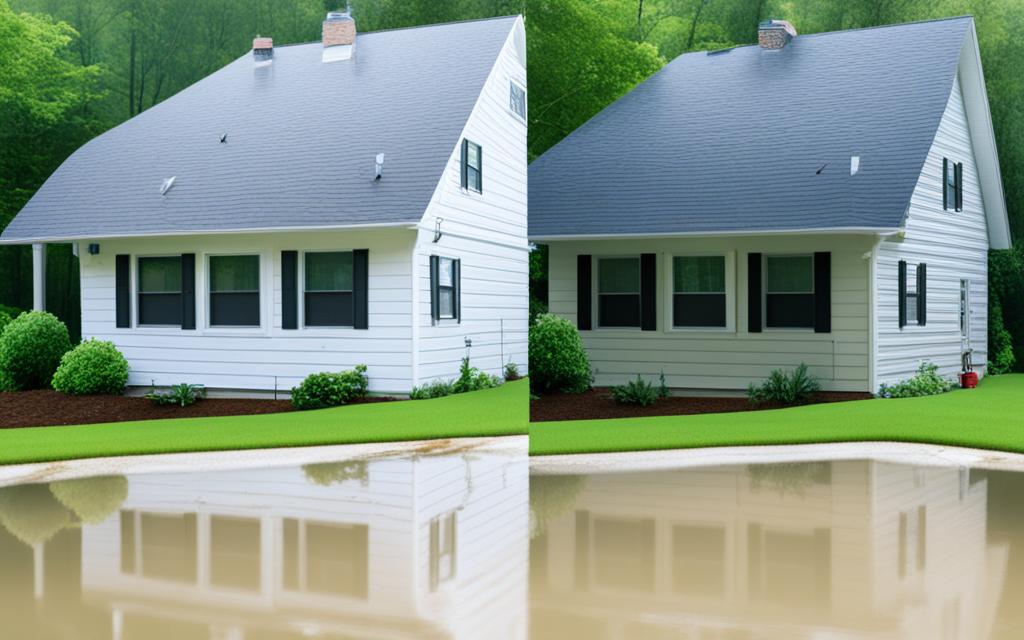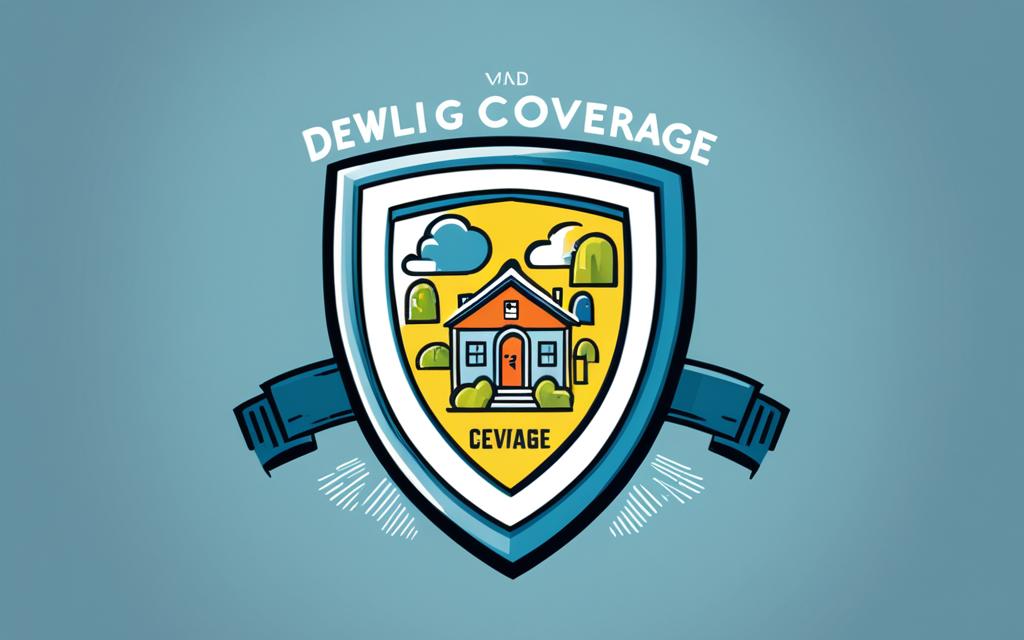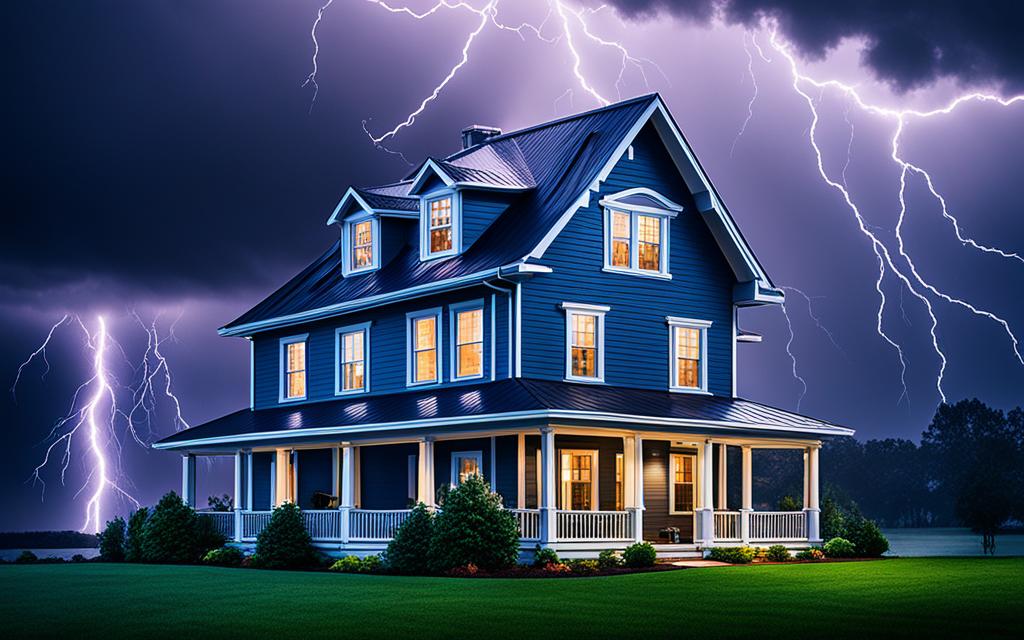Safeguarding your home is key as a homeowner. It ensures peace of mind and protects your investment. Homeowners’ insurance costs can differ widely, impacted by many variables.1 For instance, the average cost for a policy covering a $300,000 home is $2,151 annually.1 Factors like where your home is, its age, materials, and your chosen coverage determine the premium, among others.1
Key Takeaways
- Comprehensive homeowners’ insurance coverage provides peace of mind and protects your most valuable asset.
- The average cost of home insurance for $300,000 in dwelling coverage is $2,151 per year as of April 2024.
- Factors like location, home characteristics, and insurance score can impact your homeowners’ insurance premium.
- Replacement cost coverage and additional protection options like USAA Home Protector offer enhanced coverage.
- Bundling, smart home discounts, and claims-free discounts can help you save on your homeowners’ insurance premiums.
Understanding Homeowners’ Insurance Premiums
It’s important for homeowners to know their insurance premiums well. Your premium is the money you pay to keep your insurance active for a term. Most insurers let you choose how often you pay, whether that’s monthly, quarterly, or yearly.2
What is a Homeowners’ Insurance Premium?
Your premium is the amount you pay to keep your home coverage. It depends on things like the coverage you pick, where your home is, and its features.2
How Much is the Average Homeowners’ Insurance Premium?
The average cost for $300,000 in coverage is $2,151 a year in the U.S., as of April 2024. But this price can change based on your home’s location, age, its condition, and your insurance score.1
Difference Between a Quote and a Premium
A quote is a rough price based on the info you give when asking. The premium is the actual amount you’ll pay for your policy.2 The final cost might not match your original quote, due to new factors or coverage changes.
Factors Influencing Your Homeowners’ Insurance Premium
Determining your homeowners’ insurance premium involves several factors. The coverage you need plays a big role.3
For instance, higher dwelling coverage can raise your yearly costs.
Coverage Types and Amounts
The cost of insurance changes with the dwelling coverage. It varies from $946 to $3,066 yearly. This depends on if you have $100,000 or $500,000 in coverage.3
Higher deductibles also lower premiums. This rule applies across the insurance field.3
Location
Your home’s location affects your premium too.4 Insurers look at ZIP codes to judge crime and weather risks.
In California, living in a high wildfire risk area can make your insurance 15%-300% more expensive.5 Florida homes, at risk of hurricanes, might pay over $4,000 a year on insurance.
Structural Elements of Your Home
Home details matter, like age and size. These help pick the right coverage.4
Older homes usually pay 75% more for insurance than new ones.5 Making your home safer or more valuable through renovations can also change your premium.3
Insurance Score
Your credit affects your premium in most areas.4 A good credit-based insurance score can lower your rate.4

Homeowners’ Insurance Benefits: Comprehensive Coverage
As a homeowner, you must have thorough coverage to protect your home. The main part of homeowners’ insurance is replacement cost coverage. This covers your personal items at today’s prices without any decrease.6 So, if a disaster happens, you can rebuild your home and replace your items just like they were before.
Replacement Cost Coverage
USAA Home Protector insurance goes even further. It adds 25% more for rebuilding, removes debris, and covers building codes.6 This means you have extra help to fully recover after a loss and restart your life.
Additional Protection Options
You can also add extra protection through optional features. This can include covering more of your living expenses if you need to move for a while. It also adjusts your dwelling insurance to match higher building costs over time.6 With these upgrades, you know your home and what’s inside are shielded from many dangers.
Flexibility and Convenience in Claims Process
The claims process is key for homeowners like you. USAA makes claiming easy with flexible, convenient options. You can tweak your coverage and adjust when you pay to match your needs.7
Customizable Coverage
At USAA, shaping your home insurance is simple. Adjust your payment date to fit your budget. This makes everything go smoothly for you.7
Online Claims Filing and Tracking
It’s simple to file and follow up on claims with us. Policyholders can submit claims online. Then, they can track progress easily. This makes things faster and more clear for you.8
Network of Trusted Contractors
When fixes are needed, you can trust our network of contractors. They are handpicked for top-notch work. You’ll have your home back better in no time, all meeting your standards.8
USAA cares about making your claims experience great. They offer flexible coverage, online claim tools, and trusted professionals. This is the kind of support all homeowners need.87
Special Benefits for Military Members
If you’re in the military, some insurance perks come your way. For instance, your insurer will replace your uniforms without you having to pay a deductible, even if you’re away on duty9. They’ll also look after your gear. If it gets lost or broken in a war, you won’t be charged any deductible9.
Another perk for military folks is cheaper home insurance. On average, they pay $2,316 yearly. This is $195 less than what other homeowners fork out9. The budget-friendly option for them is to go with Island Insurance Company, Tokio Marine Insurance, or Union Mutual. Here, the yearly average drops to a sweet $9359.
USAA is big on giving those who serve a break on home insurance. Only military personnel, veterans, and their families can sign up9. But, if you’re deployed, your policy might get a bit tricky due to things like occupancy clauses. Yet, companies like Geico, Farmers, and Liberty Mutual are there to help with special military discounts9.
To get these discounts, a few things matter. Like how long you’ve been in the service, if you’re on active duty now, or your past deployment status9. Oh, and don’t forget about the VA loans. They offer sweet deals on mortgages for military members, veterans, and their spouses. It’s all about competitive interest rates with no down payment needed9.

Discounts and Bundling Opportunities
As a homeowner, you can save money in various ways. A key method is to use discounts and bundling. Bundling your home and auto insurance can cut your premium by up to 10%.10
Bundle and Save
If you insure your home and car with one company, you save more. The average discount for this is about 18%.10 For a $5,000 yearly insurance cost, this means you could save $900.10 You may qualify for group discounts too, which let you save on premiums without bundling, through insurers like Nulty Insurance.10
Connected Home Discount
By adding smart devices that protect your home, you could get a discount. The USAA Connected Home program, for instance, offers this. Thus, the cost of these devices can be partly covered, offering extra peace of mind.
Protected Home Discount
Installing systems that monitor for fires or secure your home might lower your insurance by up to 5%.11 These systems protect your property and show you take its safety seriously to insurers.
Claims-Free Discount
Not having filed a claim for five years could lead to big savings. Some companies give up to 15% off. This shows you take good care of your property and are a responsible homeowner.
Using these tips can help you save a lot on your homeowners insurance. This means more money in your pocket and the right coverage for your house that’s also affordable.
Homeowners’ Insurance Benefits: Flood and Umbrella Coverage
Standard homeowners policies usually don’t cover floods. It’s smart for homeowners to get a separate flood insurance, even not in high-risk zones.12 Also, an umbrella policy adds more liability coverage than what the homeowners’ policy offers.
Flood Insurance
Floods can happen anywhere, not just in high-risk areas.12 Those in normally safe places might want flood insurance too, for better protection. It helps pay for home repairs after flood damage and for replacing lost or damaged items.
Umbrella Insurance
An umbrella policy gives more liability coverage than the standard one. It shields assets from lawsuits that go beyond primary insurance limits. This is great for those with a lot to protect, like extra homes or valuable items, ensuring their personal liability is fully covered.
With both flood and umbrella insurance, homeowners get stronger protection. This offers more peace of mind, safeguarding their home well.

Valuable Personal Property Coverage
Being a homeowner, it’s key to protect your valuables. This includes items like jewelry, smartwatches, guns, cameras, and musical instruments. The Valuable Personal Property (VPP) policy from USAA ensures these are properly covered. And all this starts at just $2 a month.13
Your regular home or renter’s insurance might not cover the full value of pricey items. This could leave you at risk if they’re stolen or damaged.13 VPP coverage makes sure you’re not out of pocket when claiming for these special items. Plus, it covers personal items taken from your car. Normal car insurance doesn’t do this.13
When you get VPP coverage, make sure to describe your items well. Tell them how much each piece is worth.13 If you lose something, they’ll want proof that it’s yours. Sometimes, you might need an expert to say how much it’s worth.13
This VPP policy also pays to replace your items. So, if something’s stolen or breaks, you get a similar new one. The coverage goes up to a certain amount.13 Knowing this, you can relax. Your special stuff is all taken care of, no matter what.
| Valuable Item | Coverage Details |
|---|---|
| Jewelry | Your basic personal policy might limit jewelry coverage. Add more if you have pricier pieces.14 |
| Smartwatches | High-tech gadgets could be undercovered by your basic policy. Check and get extra coverage if needed.14 |
| Guns | Your firearms might not be fully covered. As personal property, they might need more insurance.14 |
| Cameras | A regular policy may not protect your cameras well. High-value equipment needs special attention.14 |
| Musical Instruments | If your instruments are pricey, they might need their own insurance. This makes sure they’re protected.14 |
By getting a Valuable Personal Property policy, you’re safe. Your favorite items are guarded, and you can enjoy them worry-free.
Determining the Right Coverage Amounts
Being a homeowner means making sure your insurance coverage is just right. Dwelling coverage is a key part of this. It’s about insuring your house for what it would cost to rebuild, not the market price.1516 This helps make sure you can fully fix your home if something happens.
Dwelling Coverage
Figuring out the right dwelling coverage is based on your home’s details like size and materials. Insurance companies use this info to set the rebuilding amount.16 Having the correct dwelling coverage brings you peace of mind and financial safety.
Personal Possessions Inventory
Along with your house, it’s smart to list everything you own. This list helps to decide how much personal property coverage you need. The majority of policies cover personal items between 50 to 70 percent of the dwelling coverage.1516
Liability Coverage
Enough liability coverage is crucial to safeguard your assets. Basic liability insurance starts at $100,000 but $300,000 to $500,000 is often better.15 If you own a lot or have big investments, an additional excess liability or umbrella policy could be wise.15

Replacement Cost vs. Actual Cash Value
Choosing between replacement cost and actual cash value for your home insurance is key. Replacement cost means your home or items will be covered at today’s value. This includes rebuilding or replacing them without subtracting for depreciation.17 Actual cash value, on the other hand, includes depreciation. It factors in the wear and tear, giving a lower payout if you make a claim.
With replacement cost, you get what you originally paid or the item’s current cost without depreciation deduction.17 There are also options that give you more coverage. For instance, extended replacement cost raises your coverage over the RCV. This is by 10% to 50%. Guaranteed replacement cost provides full coverage to repair or rebuild your home to its original state. All this is besides the deductible. If your home is old or unique, you could choose modified replacement cost. This option covers the use of current materials for repairs.
RCV doesn’t consider depreciation in the payout you receive. It’s for both home and item coverage. However, ACV mostly applies to personal belongings.17 Things to think about when picking include how much you’re willing to pay in premiums. Also, the condition, age of your stuff and your ability to withstand risk should be considered. Additionally, if you have a home loan, or need to manage your cash well, this choice is crucial.
Let’s take a bed frame as an example. It was bought for $3,500 and now is valued at $2,000 with ACV. So, the insurer would pay $2,000 minus any deductible. With RCV, the whole cost for a new bed frame and mattress would be paid, minus the deductible.17 The same applies to cars: ACV repays your car’s devalued price, while RCV covers the full cost of a new vehicle.
Water Damage and Mold Coverage
As a homeowner, you can feel safe because your policy covers sudden water damage from things like burst pipes or faulty appliances.18 However, it usually won’t protect you from water damage that builds up over time or from mold caused by flooding.18
Many states include mold coverage if it’s a result of a water damage claim.18 Yet, standard policies often leave out the costs of removing mold after a loss.18 Acting fast is key, as mold can appear within a day after water exposure.1819
To make sure your water damage and mold claims get approved, report hidden damage fast.18 Also, take steps to protect your home before the insurance adjuster arrives.18 And, for mold, always use a qualified expert for cleanup.18
| Water Damage and Mold Coverage Insights | Key Statistics |
|---|---|
| Sudden and accidental water damage coverage | 18 Most homeowner and renters policies cover this type of damage. |
| Gradual water damage and mold coverage | 18 Most home policies do not cover damage from gradual leaks or seepage, including mold. |
| Mold remediation coverage | 18 Many home policies do not include mold cleanup and testing after a damaged item is removed. |
| Mold growth timeline | 1819 Mold can start growing within a day after a leak, and can form on damp surfaces in as little as 24 hours. |
| Mold remediation costs | 19 The average cost of mold remediation in the United States is $2,235. |
| Deductible for mold claims | 19 The US average homeowner insurance deductible is $2,000. |
Knowing what your insurance covers regarding water damage and mold is crucial.18 It helps you deal with any unforeseen problems and keeps your home safe.
Short-Term Rental Coverage
If you rent your home out for short periods, your regular homeowners insurance might not fully cover you. In these cases, adding special home sharing coverage is wise.20 This extra policy can help keep you and your guests safe.20
Short-term rental insurance often includes guest liability, property protection, and coverage for theft.20 Plans usually go up to $1 million or $2 million for injury and property damage costs.20 Airbnb’s coverage can reach $1 million for hosts at fault, with Vrbo offering $1 million as well.20
For even better coverage, look into Proper Insurance. They provide specific short-term rental plans with options that include business liability coverage in California.21 This insurance covers things like squatter and bed bug issues,20 plus your business revenue’s protection without a specific time limit.21 It also ensures liability for common amenities, whether on or off your property, like bikes and hot tubs.21
Most short-term rental plans won’t include damage on purpose, some theft, loss of income, or the guests’ belongings. They also don’t often cover flooding or earthquakes.20 However, they are still a good idea if you rent out frequently. They keep you safe from lawsuits caused by injuries or property harm.20
| Coverage Comparison | Airbnb | Vrbo | Proper Insurance |
|---|---|---|---|
| Liability Coverage | Up to $1 million | Up to $1 million | $1 million or $2 million |
| Property Damage | Up to $3 million | Not specified | Included |
| Squatter Protection | Not included | Not included | First-to-market coverage |
| Bed Bug/Flea Protection | Not included | Not included | Customized coverage |
| Amenities Liability | Limited | Limited | Covers on and off-property |
Understanding what your short-term rental needs are, and checking out options like Proper Insurance, can really help. Homeowners will feel secure knowing they have the best coverage for their property and their guests.
Switching Homeowners’ Insurance Providers
Switching homeowners insurance providers is easy. Homeowners must remember to purchase the new policy first, before dropping the old one.22 It’s wise to inform the mortgage servicer beforehand. Let them know about the plan to change and inform them when the new policy takes effect.
Last year, only 13% of homeowners changed their insurance to get a better price.22 But, the insurance market is seeing tough times. It’s because there have been many claims due to disasters. This could lead to higher premiums in the future.22 From May 2022 to May 2023, 94% of homeowners saw their premiums go up. Some states had an over 30% rise, showing big shifts in prices.22
Experts advise checking your homeowners insurance policies every one to two years.23 Any premium increase or life changes mean you should reevaluate your policy.23 Regular checks can help make sure you’re getting the best coverage and value.23
When you’re switching insurers, get all your policy details together. Think about what coverage you need, get different quotes, purchase a new policy, and inform your mortgage company.22 It’s also important to compare quotes carefully. This prevents choosing a policy with less coverage just because it’s cheaper.23 And, looking at a company’s ratings and strength helps pick the right insurer.23
It’s a good idea to look for new home insurance every year. This shows how the industry changes and the value of keeping an eye on your options.22 Knowing what affects your insurance cost and changing when necessary helps homeowners protect what matters most.
¢
Conclusion
Securing the right homeowners’ insurance is key for homeowners. They should know about premiums and coverage options. This way, they can protect their homes and belongings well.
Lenders usually need homeowners insurance to finance a home. Such policies cover many things, like house repairs and personal items. But they often exclude earthquakes or floods. In these cases, more coverage could be necessary, depending on where you live.24
Getting home insurance is fast and simple. Quotes take just a few minutes, and policies can be ready in one to three days. It’s also a requirement before the home purchase is final. Homeowners should keep this coverage even after paying off their mortgage. It’s crucial for safeguarding their investment.24
Choosing the right coverage can save a homeowner a lot of money. Things like having a home security system can lower your premiums. With the right coverage and easy claims, homeowners can feel secure. Their homes and personal items are safe.
In conclusion, having homeowners’ insurance that fits your needs is very important. It protects your biggest investment. With the right knowledge, you can choose the best coverage. This way, you and your home stay safe and secure.
FAQ
What is a homeowners’ insurance premium?
How much is the average homeowners’ insurance premium?
What is the difference between a quote and a premium?
What factors influence my homeowners’ insurance premium?
What are the benefits of replacement cost coverage?
What additional protection options are available?
How can I save money on my homeowners’ insurance premium?
Does my homeowners’ policy cover flood damage?
How do I determine the right coverage amounts for my home?
What is the difference between replacement cost and actual cash value?
Does my homeowners’ policy cover water damage and mold?
How do I get coverage for my short-term rental property?
How do I switch homeowners’ insurance providers?
Source Links
- https://www.bankrate.com/insurance/homeowners-insurance/what-is-a-homeowners-insurance-premium/
- https://www.investopedia.com/insurance/homeowners-insurance-guide/
- https://www.policygenius.com/homeowners-insurance/factors-affecting-home-insurance-premiums/
- https://www.bankrate.com/insurance/homeowners-insurance/factors-that-impact-home-insurance-rates/
- https://www.experian.com/blogs/ask-experian/factors-that-impact-homeowners-insurance-costs/
- https://www.usnews.com/insurance/homeowners-insurance/what-does-homeowners-insurance-cover
- https://www.travelers.com/resources/home/insuring/what-to-look-for-in-a-home-insurance-company
- https://iink.com/blog/payments-simplified-why-digital-payments-are-shaking-up-property-insurance-claims
- https://www.marketwatch.com/guides/insurance-services/homeowners-insurance-for-veterans/
- https://www.consumerscu.org/blog/pros-and-cons-of-bundling-home-auto-insurance
- https://www.nerdwallet.com/article/insurance/home-insurance-discounts
- https://ggisource.com/personal-insurance/homeowners-flood-earthquake-umbrella/
- https://www.usaa.com/inet/wc/insurance-home-valuable-personal-property
- https://www.nerdwallet.com/article/insurance/personal-property-insurance
- https://www.iii.org/article/how-much-homeowners-insurance-do-you-need
- https://www.bankrate.com/insurance/homeowners-insurance/how-much-homeowners-insurance/
- https://www.usnews.com/insurance/homeowners-insurance/actual-cash-value-vs-replacement-cost
- https://www.tdi.texas.gov/tips/when-are-water-damage-and-mold-covered-by-insurance.html
- https://www.nerdwallet.com/article/insurance/does-homeowners-insurance-cover-mold
- https://www.forbes.com/advisor/homeowners-insurance/home-sharing-insurance/
- https://www.proper.insure/short-term-rental-insurance/california/
- https://www.policygenius.com/homeowners-insurance/how-to-switch-homeowners-insurance-companies/
- https://www.bankrate.com/insurance/homeowners-insurance/changing-homeowners-insurance/
- https://www.travelers.com/resources/home/insuring/do-i-need-homeowners-insurance-and-when-should-i-buy-it

